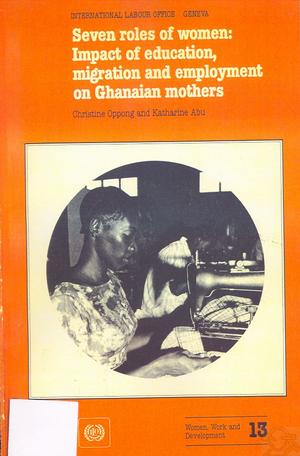Seven roles of women: Impact of Eduation, Migration and Employment on Ghanaian Mothers
İÇİNDEKİLERContents PREFACE I. WOMEN'S ROLES AND STATUSES: THE FERTILITY CONNECTIONS 1. Introduction 1.1 The problem: Models, methods and evidence 1.2 Education and fertility 1.3 Migration and fertility 1.4 Women's work and fertility 1.5 A need for new models, concepts and data 1.6 The seven roles framework 2. The Case of Ghana: Fertility Contrasts and Changes 2.1 Micro approaches: Roles, relationships and resources 2.2 Parenthood: Changing resources, expectations and conflicts 2.3 Education 2.4 Occupations 2.5 Summary comment II. GHANAIAN WOMEN 1. The Country Context 1.1 The economy 1.2 Social and spatial mobility 1.3 Education 1.4 Employment 1.5 Demographic situation 1.6 National population policy 2. Women's Roles 2.1 Workers 2.2 Status of employed women 2.3 Wives 2.4 Mothers 2.5 Housekeepers 2.6 Kin roles 2.7 Community roles and individualismIII. THE METHOD, THE SAMPLE AND THE STUDY 1. The Biographical Approach to the Study of Social Change 1.1 Data collection: Focused interviewing 1.2 Data analysis 2. The Sample 2.1 The Ga 2.2 The Dagomba 2.3 Ethnic similarities and contrasts 2.4 Mobility and migrant status IV. SIXTY EDUCATED WOMEN: THEIR SEVEN ROLES 1. Occupational Role 1.1 Type of work 1.2 Hours spent at work outside the home 1.3 Strain and deprivation 1.4 Desire for change 2. The Domestic Group: Living Arrangements 2.1 Sources and type of housing 2.2 Domestic groups and household help 2.3 Dissatisfaction with domestic arrangements 3. Kinship 3.1 Kinship and education levels 4. Community Participation and Individual Pursuits 5. Husbands and Wives 5.1 Conjugal relationships 6. Motherhood 6.1 Maternal rewards 6.2 Child-care: tradition 6.3 Transfers of children 6.4 Involvement of fathers in child-care 6.5 Consciousness and innovation 6.6 Ambition and individualism6.7 Maternal role innovation and role attributes 6.8 Conflict and strain 6.9 Conclusion V. BIRTHS: TIMING AND NUMBER CONTROL 1. Timing of the First Birth 2. Spacing of Births 3. Procreation and Marriage 4. Kinship and Procreation 5. Family Size 5.1 The older mothers 5.2 The middle age group 5.3 The younger women 5.4 Deviants 6. Birth Control 6.1 Young Dagomba in Accra 6.2 Role differences and birth control 7. Conclusions VI. CONCLUSIONS BIBLIOGRAPHY Figures Figure II. 1 Cost of living in Ghana 1979-81 Tables Table II. 1 Percentage literate, aged 15 years and over by sex, 1971 Table II. 2 School attendance of females 15 years and over by regionTable II.3 Demographic conditions in Ghana, 1975-80 Table II.4 Female population aged 15-49: Labour force activity rates by urban/rural population, 1970 Table II.5 Percentage distribution of women aged 15 to 49 years, by marital status, 1970 Table II.6 Mean number of children ever born, by age group Table II.7 Mean number of children ever born to ever-married women, by years since first marriage and level of education Table II.8 Average numbers of children born alive by marital status and age group to urban women Table II.9 Employment status and completed family size of urban, suburban and rural women Table 11.10 Percentage of women knowing different methods of contraception Table III.l Categories of women selected Table III.2 Educational levels reached by wives and husbands Table III.3 Husband's educational level in relation to wife Table IV. 1 Role profiles: Priority, satisfaction and status Table IV.2 Role strain, relative deprivation and desire for change Table IV.3 Occupational role attributes by ethnicity, age and migration status Table IV.4 Mean longest periods spent separated from children under 12 yearsTable IV.5 Fathers' involvement in child-care by ethnicity, wife's age group and migration status Table V.I Children by ethnicity, age and migration status Table V.2 Mean number of abortions and scores for contraceptive use by ethnicity, age group and migration status    |



